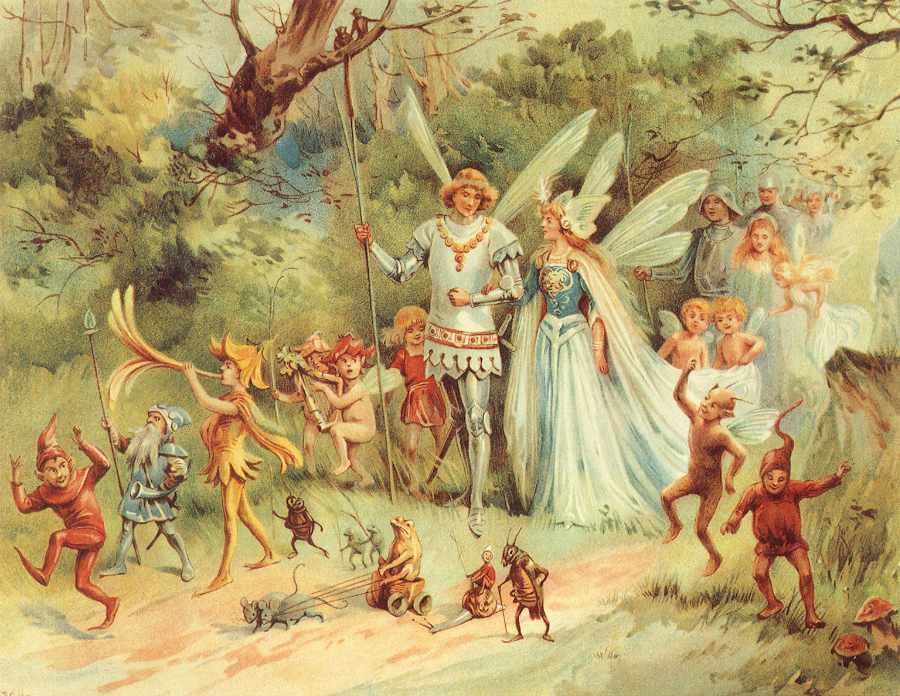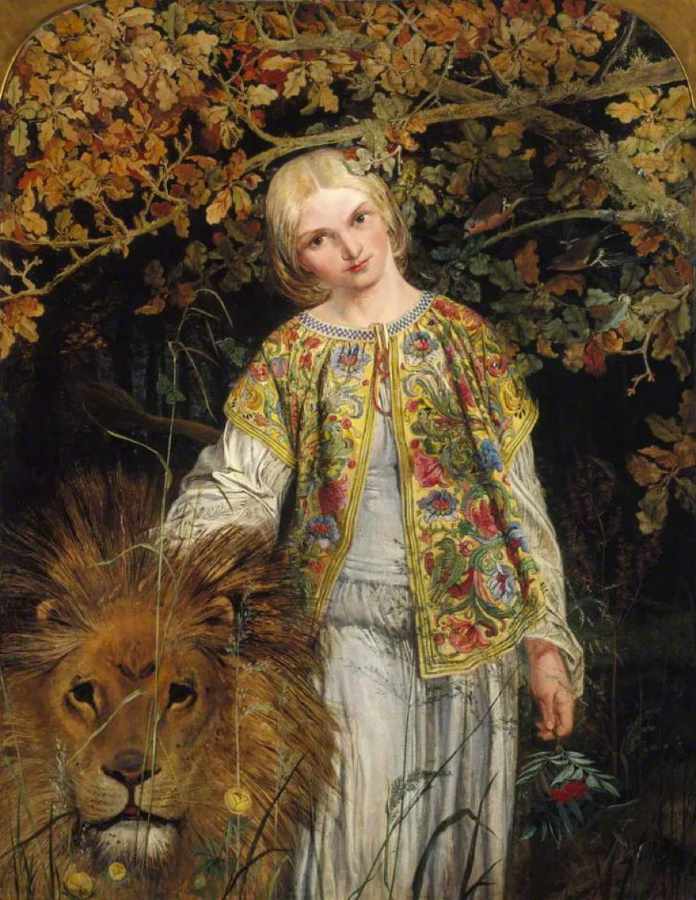The Fairy Queen, or Queen of the Fairies, is a figure from Irish and British folklore, believed to rule the fairies. Based on Shakespeare’s influence, in English-speaking cultures she is often named Titania or Mab. In Irish folklore, the last High Queen of the Daoine Sidhe – and wife of the High King Finvarra – was named Una (or Oonagh, or Oona, or Uonaidh etc.). In the traditional ballad of Northern England and Lowland Scotland, she was called the Queen of Elphame. For example, in accounts of the Scottish witch trials, The Queen of Elphame and Queen of Elphen are referenced, and a Queen of Elfland appears in the traditional ballad “Thomas the Rhymer”. The poem “The Faeries of Fawdon Hill” describes a Fairy Court presided over by Queen Mab. In the children ballads Tam Lin and Thomas the Rhymer, she is represented as both beautiful and seductive, and also as terrible and deadly. The Fairy Queen is said to pay a tithe to Hell every seven years, and her mortal lovers often provide this sacrifice. Both Edmund Spenser and William Shakespeare used folklore concerning the Fairy Queen to create characters and poetry, Spenser in the poem The Faerie Queene and Shakespeare most notably in A Midsummer Night’s Dream. Also known as Gloriana and Titania. In William Shakespeare’s A Midsummer Night’s Dream, written in 1595/96, Oberon is the king of all of the fairies and is engaged in a dispute with his wife Titania, the fairy queen. They are arguing over custody of a child whom Oberon wants to raise to be his henchman. Titania wants to keep and raise the child for the sake of her mortal friend and follower who died giving birth to him.
| Alias Fairy King & Queen |
| Real Names/Alt Names Queen: Gloriana, Tanaquill, Titania, Mab, Una, Oonagh, Oona, Uonaidh; King: Oberon, Auberon |
| Characteristics Magician, Film Characters, Magic Caster, Flight, Prehuman Epoch |
| Creators/Key Contributors Unknown |
| First Appearance English folklore |
| First Publisher ○ |
| Appearance List A Midsummer Night’s Dream by William Shakespeare, “The Elves’ Gift: The Veritable Narrative of Thomas Graspen” by Arthur Crosby, St. Nicholas, vol. 1, no. 3, Jan. 1874, “Thomas the Rhymer” (poem), “The Faeries of Fawdon Hill” (poem), The Faerie Queene by Edmund Spenser, “Nimphidia” (1627) by Michael Drayton, Robin Goodfellow, His Mad Pranks and Merry Jests (1628), Holger Danske (Danish opera, 1789), Faust I by Johann Wolfgang Goethe, Oberon (1826, opera) by Carl Maria von Weber |
| Sample Read A Midsummer Night’s Dream [PG] |
| Description The Fairy Queen, or Queen of the Fairies, is a figure from Irish and British folklore, believed to rule the fairies. Based on Shakespeare’s influence, in English-speaking cultures she is often named Titania or Mab. In Irish folklore, the last High Queen of the Daoine Sidhe – and wife of the High King Finvarra – was named Una (or Oonagh, or Oona, or Uonaidh etc.). In the traditional ballad of Northern England and Lowland Scotland, she was called the Queen of Elphame. For example, in accounts of the Scottish witch trials, The Queen of Elphame and Queen of Elphen are referenced, and a Queen of Elfland appears in the traditional ballad “Thomas the Rhymer”. The poem “The Faeries of Fawdon Hill” describes a Fairy Court presided over by Queen Mab. In the children ballads Tam Lin and Thomas the Rhymer, she is represented as both beautiful and seductive, and also as terrible and deadly. The Fairy Queen is said to pay a tithe to Hell every seven years, and her mortal lovers often provide this sacrifice. Both Edmund Spenser and William Shakespeare used folklore concerning the Fairy Queen to create characters and poetry, Spenser in the poem The Faerie Queene and Shakespeare most notably in A Midsummer Night’s Dream. Also known as Gloriana and Titania. In William Shakespeare’s A Midsummer Night’s Dream, written in 1595/96, Oberon is the king of all of the fairies and is engaged in a dispute with his wife Titania, the fairy queen. They are arguing over custody of a child whom Oberon wants to raise to be his henchman. Titania wants to keep and raise the child for the sake of her mortal friend and follower who died giving birth to him. |
| Source Fairy Queen – Wikipedia |


